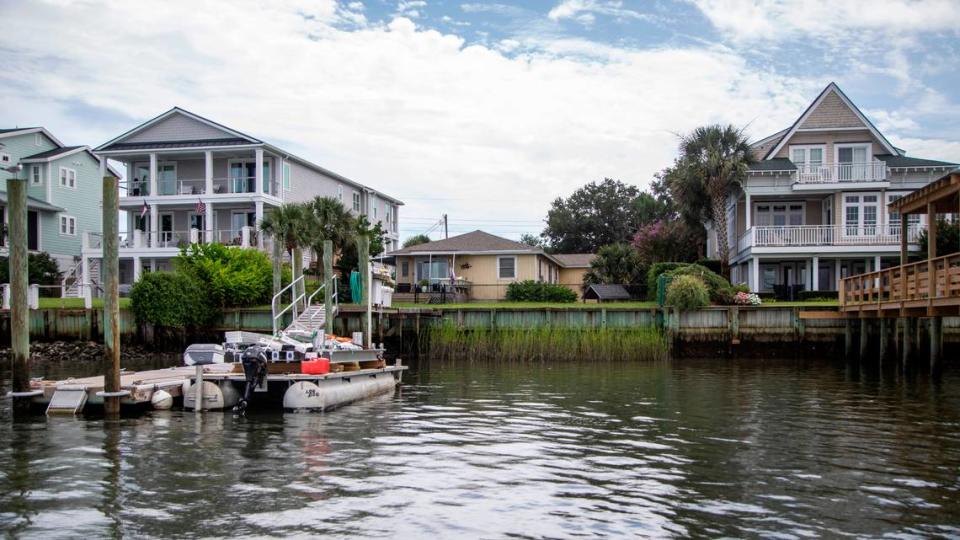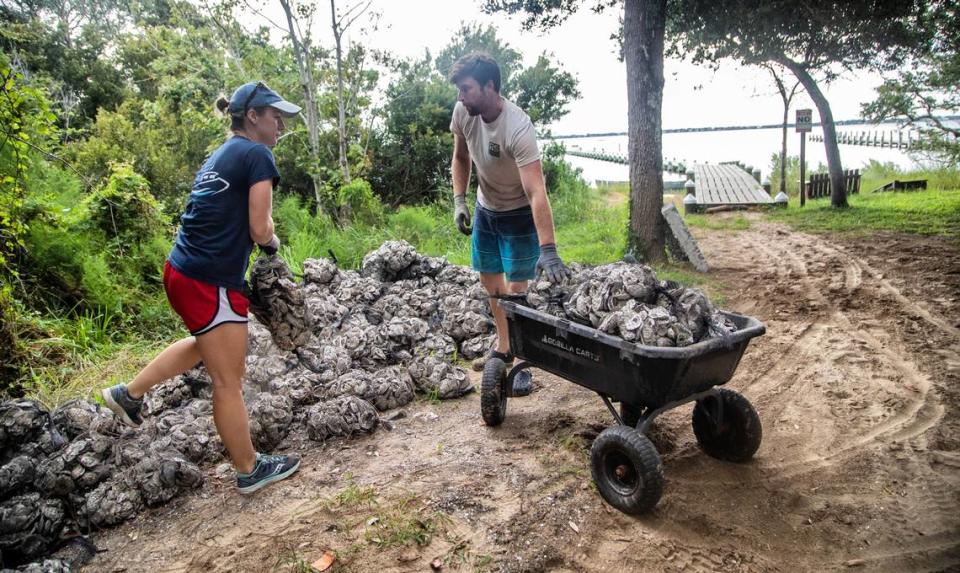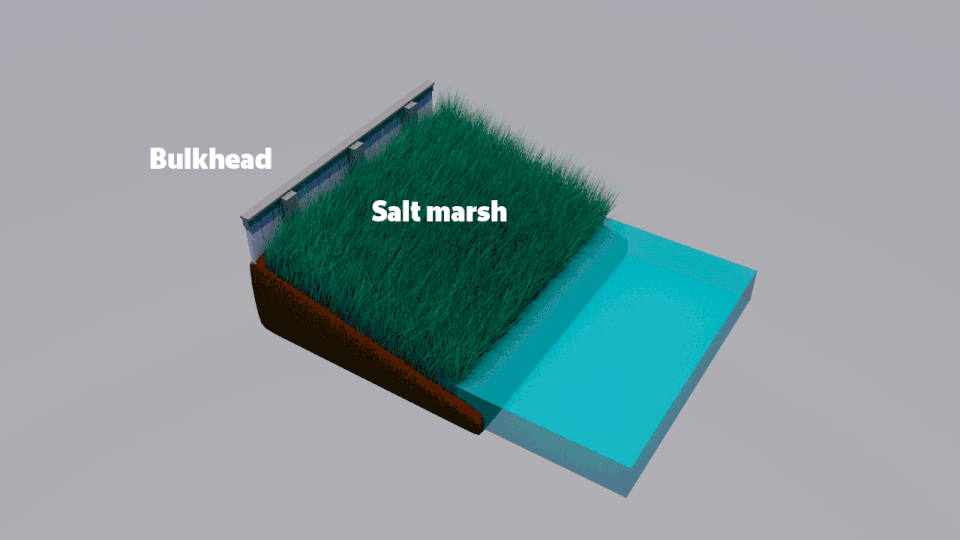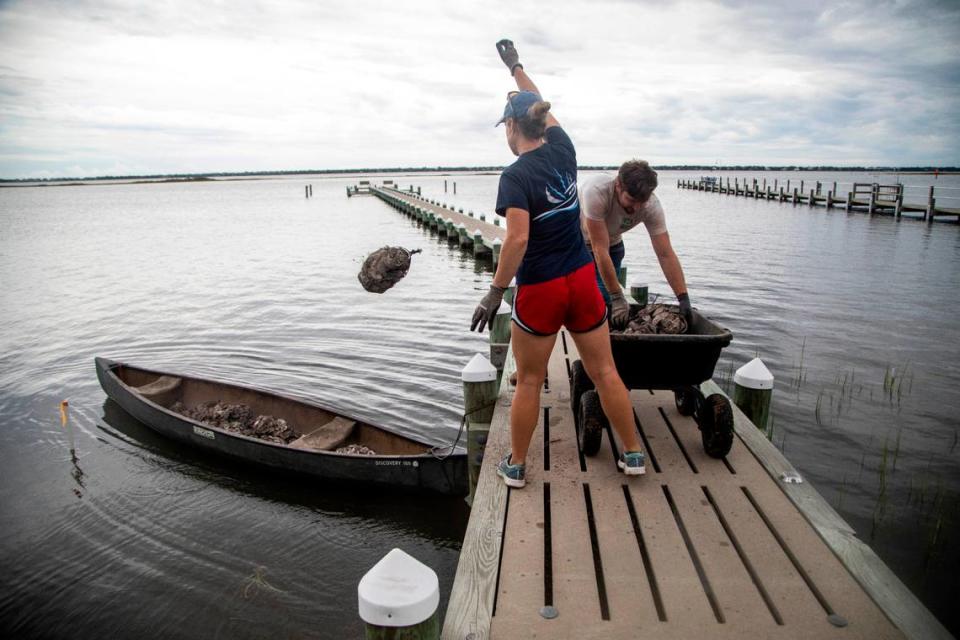What is a living shoreline, and how could it save one of NC’s most valuable ecosystems?
Scientists and coastal advocates agree: Bulkheads are bad news for salt marshes.
The vinyl or wooden structures that have long been the go-to solution along North Carolina’s estuaries and sounds, but they threaten the valuable wetlands that sit just offshore.
“If you put in a big engineered system like a bulkhead, you’re starting the countdown on how long the marsh in front of it, if there is any, is going to last,” said Michael Piehler, a professor at UNC-Chapel Hill’s Institute of Marine Sciences.
With a bulkhead behind a marsh, Piehler said, the ecosystem is threatened by wave energy from the front and back sides, with water slapping off of the vinyl or wood and bouncing back across the grasses and soil. This is particularly pressing because salt marshes face a “coastal squeeze,” with rising sea levels threatening to drown marshes in place and development preventing them from retreating.
The answer, advocates say, is living shorelines, a term that encompasses breakwater structures built out of material like oyster shells, granite or limestone marl below the high tide line. Where bulkheads are designed to bring waves to a sudden and forceful halt at a defined line between land and water, living shorelines are meant to take much of the energy out of waves before they wash ashore.
By slowing the water down, the sediment that it is carrying has a chance to fall away, said Lexia Weaver, a N.C. Coastal Federation scientist and manager of the non-profit’s Newport office. Over time, the sediment builds up and the marsh growing there will have a better chance of keeping pace with rising sea levels.
There are a wide range of other benefits, too.
“With a living shoreline, you’re definitely able to keep that valuable habitat. That’s going to help with fisheries,” Weaver said. “It’s going to help with water quality by keeping the turbidity down, keeping the nutrients down, the pollution, and it’s just a more productive system.”

A new North Carolina policy?
North Carolina coastal officials have long been intrigued by the environmental benefits of living shorelines and potential cost savings, particularly after storms.
Generally, state coastal development officials have helped spread the word about living shorelines through workshops with real estate agents and marine contractors.
That could soon change, with the coastal agency exploring the possibility of a shoreline development rule similar to one recently passed in Virginia that made living shorelines the standard for coastal shoreline protection. Under the Virginia rule, property owners could only build bulkheads or riprap in circumstances where a living shoreline would not provide adequate protection.
Braxton Davis, the director of North Carolina’s Division of Coastal Management, said the Coastal Resources Commission could begin discussing a rule as soon as November’s meeting.
“We want to talk more with the folks in Virginia and learn how that’s worked on the ground level — like what were the reasons cited for kind of overriding that preferential law? In what situations were exemptions granted? And then we’re planning on bringing that very topic to the Coastal Resources Commission for consideration,” Davis said.
In North Carolina, advocates and contractors have long been focused on demonstration sites, trying to show property owners up and down the coast that living shorelines are a viable alternative.
An approach like Virginia’s would, Weaver said, be a “dream.”
“That would definitely be the next step: To prevent all these hardened shorelines from going in because even though the state is promoting living shorelines, they’re still permitting bulkheads left and right,” Weaver said.
‘Why do I need to build a wall?’
Bill Norris knows that places like the marshland his family has lived near for five generations represent a key part of North Carolina’s coastal economy.
“You would not believe the wildlife, the growth,” Norris said. “Everything originates here and goes out there. We lose this, you lose a lot of your fisheries.”
Standing on his boat dock on an overcast August afternoon, Norris points to Starkey Creek and explains how the water that passes his Carteret County home will run into Pettiford Creek Bay and then into the White Oak River, passing under a bridge at Swansboro before wending its way through salt marshes and into the Atlantic Ocean.
On either side of the dock where Norris is standing are bags of oyster shells, a technique used to create a living shoreline that North Carolina supporters have long called for landowners along North Carolina’s marshes and sounds to turn to instead of the more traditional bulkheads and riprap. Living shorelines will, supporters argue, provide much the same protection as a bulkhead while also boosting marsh grasses that slow storm surge more effectively than unprotected rock or vinyl.

Norris, who is particularly concerned about the impact sediment runoff from nearby development could be having on his beloved creek, turned to the oyster bags more than five years ago. In addition to preventing his own shoreline from eroding, he hoped the oysters would help treat some of the sediment-laden water running across his land before it reached the creek.
“I’m sure a bulkhead would benefit me as a homeowner from the surging and the water, but even during the hurricanes, the water gets up just about to where my pond is,” Norris said, gesturing to a small pond that sits about 50 feet inland from his creekside dock. “So how high would I need to build a wall? Why do I need to build a wall? I don’t know.”
He continued, “This is more practical because it’s creating growth. It’s helping (oyster) spats look for a place to land so we’ve got multiple things. We’re using a natural product back where it came from, and to me you can’t get any better than that.”
As Norris spoke, the tide was on its way in.
Oyster bags were visible on a neighbor’s property, appearing like clumps of rock along the shoreline with green marsh grass growing on the landward side.
Looking off of the side of Norris’ dock, a visitor had to peer through dark water to make out the oyster bags resting beneath, tall shocks of grass growing behind them.

What’s slowing adaptation?
The Coastal Federation and North Carolina marine scientists have been making the case for living shorelines for more than 22 years. In May 1999, Coastal Federation scientists built the state’s first living shoreline, a 190-foot stretch of granite boulders along the Intracoastal Waterway off of Northeast 35th Street in Oak Island, according to the Wilmington StarNews.
That site and other demonstration sites have, by all accounts, worked well. But bulkheads and riprap have remained the de facto answer for someone seeking to protect a North Carolina shoreline.
From January 2020 to June 2021, the N.C. Division of Coastal Management issued 336 general permits for construction of bulkheads along North Carolina’s salt marshes, 44 for riprap and 10 for retaining walls, according to records obtained by The News & Observer.
By comparison, over the same period there were five general permits issued for construction of marsh sills, the low mounds of granite or oyster shell that often make up living shorelines.
Weaver, of the Coastal Federation, said continuing to raise awareness is key.
“Contractors are not aware of the concept and a lot of property owners are not aware of it, too, because compared to bulkheads there are only a handful of living shoreline projects that are in the ground or in the water,” Weaver said.
Bulkheads and other barriers

When tidal salt marshes are threatened by a rising sea level and erosion, they try to migrate upland. But many property owners use bulkheads and other barriers to protect waterfront property from erosion, and these have walled off tidal marshes all along the Southeastern coast. An alternative to that is what is known as a living shoreline. The use of materials such as oyster shells, native marsh grasses, wood, limestone, rip rap, as well as construction setbacks and slopes, and plantings of marsh grass help limit erosion and protect the marshes.
From 2016 to 2021, the state’s coastal management division sponsored 13 workshops attended by 481 people including marine contractors and real estate agents, among others.
“We’re doing everything we can to encourage a transition to those approaches,” said Davis, the state coastal director, “but it is something that takes time to change.”
The Coastal Federation and other advocates of living shorelines hope that a 2019 decision by North Carolina’s Coastal Resources Commission will mark a turning point. By tweaking a pair of rules, the commission made acquiring a permit to build a living shoreline as simple as getting one to build a bulkhead — requiring only the signoff of one Division of Coastal Management field representative.
Before, anyone looking to build a living shoreline had to seek a so-called “major permit,” a more expensive process that had to undergo review from more than a dozen federal agencies.
Having the same review process for both structures is important, said Mary-Margaret McKinney, the director of coastal restoration at Restoration Systems, a Raleigh-based marine contractor.
“If you tell a landowner there’s a super easy permit to get a bulkhead but doing a living shoreline is going to be long and complicated, he’s not encouraging a living shoreline,” McKinney said. “Everything we can do to make a living shoreline easier increases the positive perception to the landowner.”

How to get a living shoreline
When someone decides to address their eroding shoreline, they might reach out directly to the Division of Coastal Management or to the Coastal Federation to see what options they have, Weaver said. If the landowner contacts DCM and expresses interest in a living shoreline, a field representative will refer them to the Coastal Federation, Weaver said.
From there, a representative of the Coastal Federation will assess the shoreline’s possibility for a living shoreline, typically in photographs first and usually with an in-person visit, followed by a list of contractors who might be able to build the breakwater.
Restoration Systems offers a similar service, McKinney said, typically followed by a quote that includes all construction and permitting fees.
“There’s very, very few places in North Carolina where some kind of living shoreline couldn’t supplement the hardened shoreline to soften the coast and increase the resiliency of that area,” McKinney said.
If permitting moves quickly, a living shoreline can be built in about a month, McKinney said. If there’s a permitting backlog, the process can take four to six months. Living shorelines typically cost $110 to $175 per linear foot, a price contractors say is competitive with bulkheads.
Cost shares are also available for many landowners, if they don’t want to or can’t afford to pay the full price of a living shoreline project. This is particularly true, Weaver said, for property owners whose wealth is mostly tied up in their homes.
The Coastal Federation is finishing spending a $400,000 grant from the N.C. Land and Water Fund. Both the House and Senate proposals of the North Carolina state budget include $2 million in this year’s budget to help fund living shoreline projects, with landowners receiving 50% of a project’s cost or $5,000, whichever is lower.
“It’s needed right now,” McKinney said of the cost share, “to help encourage people to install so that we can get to the point that there’s enough of them that the people are seeing them and really wanting them.”
Low, mid and high tides by McClatchy on Sketchfab
Holding up in a storm
Hurricanes are an inevitable part of owning property at the coast, their wind causing damage and their storm surge quickly overwhelming shorelines. Supporters of living shorelines argue that the more natural structures will hold up better under extreme conditions than bulkheads.
“The surge will go over the living shoreline, and the energy’s reduced while it does it,” Weaver said, “As opposed to when (the surge) goes over a bulkhead, that energy just keeps going and when the water comes back it ends up scouring the landward edge of a bulkhead and it gets compromised and gets damaged from there.”
Researchers understand why some people prefer bulkheads, noting that some property owners want an even property line with a turf lawn behind it. Others are skeptical that some marsh grass and oyster shells will be more effective at slowing a wave down than a hardened wall.
“If I didn’t know what I know and someone said these plants are going to protect my property as much as this wall, I would probably laugh at them. I can understand it’s a hard sell because visually they don’t look the same in terms of protection,” said Rachel Gittman, an assistant professor in East Carolina University’s Integrated Coastal Programs.
After 2016’s Hurricane Matthew, though, researchers from UNC-Chapel Hill and Northeastern University interviewed 295 homeowners on sounds in Carteret and Dare counties and the Intracoastal Waterway in Brunswick County. They found that about 24% of the homeowners with bulkheads and 12% of the homeowners with living shorelines reported damage to their property.
Earlier this year, Gittman co-authored a paper that found living shorelines held up better during Hurricane Florence than salt marshes that weren’t protected by marsh sills or similar structures.
Neighboring influence
In another paper published this year, Gittman found that neighboring properties had a significant influence on what property owners did with their own shorelines.
Published in the journal “Conservation Science and Practice” in June, the paper used surveys to see what factors helped homeowners decide what kind of shoreline to build. The answer was that hardened shorelines like bulkheads and riprap simply made people feel more strongly about building either a hardened shoreline or a living shoreline.
“If hardened shoreline owners saw a hardened shoreline, they were likely to have a hardened shoreline,” Gittman said. “If living shoreline owners saw a hardened shoreline they were more likely to have a living shoreline.”
If a property owner’s neighbor builds a new bulkhead, for instance, they could think that re-directed wave energy is beginning to impact their own shoreline, leading them to build a bulkhead, Gittman said. Or they can simply appreciate the aesthetics of a bulkhead and think that clean property lines will mean an increased property value.
On Starkey Creek, Bill Norris’ influence has moved two of his neighbors to pursue living shoreline of their own. Around 2019, the neighbor down the creek from Norris installed a shoreline.
This summer, Rick Armstrong had the first 100 feet of what he hopes is eventually about 300 feet of a living shoreline installed. Standing just feet away from the line of oyster bags that he hopes will slow his property line’s erosion, Armstrong said that Norris’ shoreline was key to his decision.
“As soon as we saw it being done, it was like, ‘What is this?’ We didn’t know anything about it and all of a sudden it was like, oh this is great. We saw the effects of it,” Armstrong said.
Actual construction of the shoreline took about a week, Armstrong said, with a contractor bringing a dump truck of oyster shells to the house’s front lawn and using an electric cart to move the shells to the shoreline. The contractor then loaded the shells into a canoe and placed them along the shoreline.
The Coastal Federation hopes that structures like the ones built by Armstrong and Norris show the potential of living shorelines.
“Everyone’s realizing that these things work,” Weaver said, “and that it’s a great way to protect against storms and those high water levels and boat wakes and any type of impact on shorelines.”
This story was produced with financial support from 1Earth Fund, in partnership with Journalism Funding Partners, as part of an independent journalism fellowship program. The N&O maintains full editorial control of the work.

